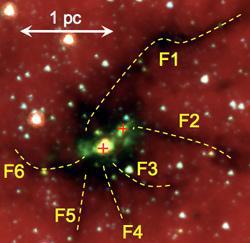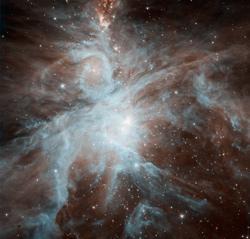Massive stars in the galaxy are pretty rare. The Sun is a big star, comparatively, bigger and brighter than about 80-90 percent of all the stars in the Milky Way. But the true monsters, stars with a whopping 100 times the Sun’s mass, are far more rare; maybe one in 10,000 stars is that big. They’re super bright, and generally unstable—they undergo pretty violent paroxysms during their short lives before exploding as a supernova.
Despite being so obvious, we know very little about how they’re born. It’s actually hard to pile that much material onto a forming star before it heats up and starts blasting out light and matter, blowing away the cocoon from which it formed. Plus the formation time is pretty short, so you have to catch it at just the right moment. Not only that, but the clouds of material from which they’re born are pretty thick, choked with dark material, making it hard to see what’s going on.
But sometimes we catch a break: Astronomers have found just such a beast. About 10,000 light years from Earth (a pretty fair distance, actually) is a dark cloud of material called SDC 335.579-0.292. The cloud is about 10 light years across, and has enough material to make well over 5000 stars like the Sun. Although the cloud is dense, the radio waves generated by the stars forming inside it can travel right through the surrounding material, where it can be detected on Earth by powerful telescopes.

Photo by Peretto et al., from their paper.
One such telescope is the brand spanking new Atacama Large Millimeter/submillimeter Array, and its view of the cloud is pretty good. Pictured above (combined with images from other telescopes), you can see the cloud has several filaments, or tendrils, that meet near the center. And right in the middle of this mess are two dense knots of material (they’re pictured in yellow in the image).
Those knots are where new stars are being born. The brighter of those two knots has a mass of well over 500 times the mass of the Sun, which is a lot. It seems likely that right in the heart of that knot a star is forming that may wind up as one of the galaxy’s most massive, tipping the cosmic scale at about 100 times the mass of the Sun!
Having read the journal paper associated with this discovery, I’ll admit I’m not 100 percent convinced this knot of material is forming a single star. It’s more of a statistical argument—given a certain amount of material you’ll get a certain number of stars of a given mass. But in this case, there’s so much material that a single star that ginormous isn’t out of the question, and is even likely.
So we may very well have a front-row seat to a massive star being born. And these observations may also just cut through an old problem in massive star formation. There are two possible scenarios to make a big star: one in which the cloud fragments as it collapses, forming several distinct regions where stars form after the fragmentation, and another in which the cloud collapses globally, all of the material forming stars at the same time as the collapse.
The new observations show the filaments appear to be streaming into the bright knots, which would seem to indicate the cloud itself is collapsing globally, feeding scads of material into the center. That’s actually a pretty big deal; I remember studying this issue in graduate school, and even simplifying the situation as much as possible it’s a tough problem to solve. When you add real-Universe physics (magnetic fields, turbulence, chemical composition of the material screwing up how it absorbs and radiates energy) this gets hair-pulling-outingly complex.

But observations, generally, win in the end, and it really looks like this entire massive cloud is on its way down. When it’s done, it may form that one huge bruiser, plus over 300 stars as massive or more than the Sun, a considerable number. As they turn on, they’ll light up their surroundings, possibly forming a structure like the gorgeous Orion Nebula. Wouldn’t that be nice? Orion is spectacular, one the galaxy’s more ostentatious nurseries.
And here we are, watching it in the early stages of construction. And now it’s like we have the blueprints too, so we even have a pretty good idea of how it’s being built.
